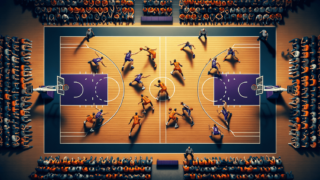
Zone Defense Rule in Basketball
Written by: Basketball Universe
Last updated:

Calling all hoops enthusiasts! Ever wondered how different defensive schemes can dictate the flow and outcome of a basketball game? Well, you’re in luck! Today, we’ll dive into the intriguing world of the Zone Defense Rule in Basketball. This strategic gem is a game-changer, often baffling opponents, and making it hard for them to find open scoring opportunities. Join us as we break down this fascinating approach, unravel its benefits and limitations, and finally, demystify the secrets that make the zone defense so effective. Ready to elevate your basketball IQ? Let’s get started!
Zone Defense Rule in Basketball
The Zone Defense Rule in basketball refers to a specific type of defensive strategy in which players are assigned to guard specific areas or “zones” rather than matching up individually against offensive players. This approach is designed to disrupt the offense by clogging passing lanes, limiting open shots, and forcing opponents to make more challenging plays. It often involves various formations, like the 2-3 or 3-2 zone, depending on the specific strategy being employed by the coaching staff.
Understanding the Fundamentals of Zone Defense
Let’s start with the basics! Zone defense is a vital component of the basketball rules toolkit that every enthusiast should know. Unlike man-to-man defense, where each player is assigned to defend a specific opponent, zone defense assigns players to cover designated areas or “zones” on the court. This defensive technique aims to limit the offense’s ability to score by forcing difficult shots, creating turnovers through steals and blocked shots, and controlling the rebounding battle.
Common Zone Formations
Zone defenses come in various shapes and sizes, each with its unique strengths and weaknesses. Some widely used zone formations include:
- 2-3 Zone: Two players at the top and three players down low – often used to protect the paint and force perimeter shots.
- 3-2 Zone: Three players at the top and two players down low – typically employed to contest outside shooters and pressure ball handlers.
- 1-3-1 Zone: Players form a “pointed diamond” shape to create an extended pressure defense and cut off driving lanes.
- 1-2-2 Zone: One player at the top, two at the wings, and two down low – a flexible zone that can easily transition to other zone formations or even man-to-man defense.
All of these formations have specific goals in mind, be it collapsing on the ball, cutting off driving lanes, or challenging outside shots. Now let’s dive deeper into each formation and how they function on the court.
Breaking Down the 2-3 Zone Defense
The 2-3 zone defense is one of the most common and traditional zone formations in basketball. Generally used to force opponents to take contested outside shots and protect the paint, this defense can be particularly effective against teams with limited shooting depth.
2-3 Zone Positioning
The 2-3 zone defense consists of five players spread across the court as follows:
- The two guards (usually the point guard and shooting guard) are positioned at the top of the key, typically just above the three-point line. Their primary responsibility is to apply pressure to the ball handler and contest outside shots.
- The three forwards (usually the small forward, power forward, and center) create a “wall” near the baseline. The middle forward is typically responsible for patrolling the paint, blocking shots, and securing rebounds, while the two wing forwards cover the corners and help collapse into the paint when needed.
2-3 Zone Principles and Goals
Teams employing the 2-3 zone will rely on the following principles and goals during games to become successful:
- Team communication: Players must communicate effectively to ensure the correct switches and rotations, particularly when the ball moves quickly.
- Active hands and feet: In this zone, all five players must consistently move, keep their hands active, and react to ball movement to maintain a solid defensive presence.
- Defensive rebounding: By occupying the paint and routinely boxing out, teams can secure rebounds and limit opponents’ second-chance opportunities.
- Disrupt offensive flow: The 2-3 zone often serves to take offenses out of their usual rhythm by forcing them to take unfamiliar or undesirable shots.
Decoding the 3-2 Zone Defense
The 3-2 zone defense is a versatile formation that emphasizes outer perimeter pressure and ball denial. With three players covering the outside, this formation seeks to deter talented shooters from long-range attempts and force offenses to play through the interior.
3-2 Zone Positioning
Players in the 3-2 zone defense are positioned as follows:
- The three perimeter players (usually the point guard, shooting guard, and small forward) form a “triangle” near the top. One player is stationed near the top of the key, offering ball pressure, while the wings extend out to pressure shooters and deny passes to the corners.
- The two post players, often the power forward and center, are positioned inside, ready to protect the paint and contest shots near the basket. They are also responsible for securing rebounds and closing off driving lanes when possible.
3-2 Zone Principles and Goals
Teams implementing the 3-2 zone defense focus on these core principles and goals:
- Pressure on the perimeter: By applying constant pressure on the ball and denying passes, the 3-2 zone forces offenses to take contested shots or play through the interior.
- Limiting three-pointers: The three perimeter players are tasked with closing out on shooters quickly and ensuring no open looks from beyond the arc.
- Paint protection: Despite the focus on the perimeter, the two post defenders must be vigilant and protect the paint, challenge interior shots, and secure rebounds.
- Forcing turnovers: The tight coverage and constant pressure provided by this zone often leads to opposition mistakes and can manufacture turnovers when executed correctly.
Examining the 1-3-1 Zone Defense
The 1-3-1 zone defense is an aggressive formation designed to confuse offenses and force turnovers. The unique “pointed diamond” player alignment creates passing lane disruptions and a highly flexible defense that can adapt quickly to various offensive strategies.
1-3-1 Zone Positioning
Players in the 1-3-1 zone defense pose unique matchup problems with their positioning:
- The single point defender (usually the point guard) applies makeup for the top opposing ball-handler, staying above the three-point line, and exerting pressure on the player.
- The three “middle” players consist of the shooting guard, small forward, and power forward, forming a line across the court with varying roles. The shooting guard and small forward are responsible for wing and corner defense, while the power forward covers the high post area.
- The center occupies the baseline, acting as the last line of defense and sole low post defender. This player will be tasked with contesting shots, blocking lanes, and grabbing rebounds.
1-3-1 Zone Principles and Goals
When employing the 1-3-1 zone defense, teams should focus on these key principles and goals:
- Creating confusion: The unusual 1-3-1 alignment is designed to bewilder opponents and force them into awkward offensive positions or errors.
- Generating turnovers: With a focus on trapping and denying passes, this defensive formation is known for its ability to generate steals and deflections.
- Contesting drives and shots: The “pointed diamond” positioning allows for swift rotations and efficient help defense, reducing open shots and driving lanes for the offense.
- Transition opportunities: By creating turnovers and altering shot attempts, the 1-3-1 zone can lead to fast-break opportunities and easy points for the defense.
Exploring the 1-2-2 Zone Defense
The 1-2-2 zone defense is a flexible and adaptive formation that can seamlessly transition to other defensive schemes or morph to counter specific offensive threats. Teams that thrive on defensive versatility will often employ the 1-2-2 zone due to its malleability.
1-2-2 Zone Positioning
Players in the 1-2-2 zone defense are positioned as follows:
- The single point defender (usually the point guard) occupies the top of the formation, pressuring the ball handler and denying access to the middle of the court.
- The two wing defenders (usually the shooting guard and small forward) are placed near the free-throw line extended, ready to defend the perimeter and help with on-ball pressure when needed.
- The two post players (usually the power forward and center) are staggered across the key and low block, prepared to contest shots, protect the paint, and secure rebounds.
1-2-2 Zone Principles and Goals
Core principles and goals for teams using the 1-2-2 zone defense include:
- Versatility and adaptability: The 1-2-2 zone lends itself to seamless transitions to other formations, such as the 2-3 or 3-2, allowing the defense to adapt to offensive strategies quickly.
- Balanced coverage:
Mastering the Art of Zone Offense
While it’s essential to understand the intricacies of various zone defenses in basketball, it’s equally crucial to recognize how to counter these tactics effectively. Strategies for attacking zone defenses can vary depending on the specific formation, but mastering some key offensive principles can help dismantle even the most well-executed zone defenses.
Ball Movement and Player Movement
Moving the ball quickly and crisply around the perimeter can force the zone defenders to shift constantly and create open space for offensive players to exploit. Likewise, regular cutting and off-the-ball movement can help disorganize the zone and find gaps for easier scoring opportunities. Keeping the defense guessing and off-balance is key when facing zone defenses.
Utilizing the High Post and Short Corners
The high post (area around the free-throw line) and short corners (areas along the baseline, a few feet from the basket) can act as “soft spots” in many zone defenses. Utilizing players in these areas can draw defenders out of position and create high-percentage scoring opportunities or open perimeter shots.
Effective Outside Shooting
One of the main aims of most zone defenses is to funnel offenses into taking contested outside shots. Becoming an effective outside shooting team can punish zone-dominant opponents and force them to adjust their strategy. A few made outside shots can go a long way in breaking down a zone defense and opening up interior scoring options.
Offensive Rebounding and Second-Chance Opportunities
Zone defenses often struggle with securing defensive rebounds due to the lack of specific box-out assignments. Crashing the boards and obtaining second-chance opportunities can help offset any difficulties navigating through the zone, making offensive rebounding an essential component when facing a zone defense.
Recognizing When to Use Zone Defense
Understanding when to employ zone defense tactics can be just as essential as knowing the specific formations themselves. While zone defensive schemes can be beneficial, they may not be the best strategy in all game situations. Recognizing when and how to utilize zone defense can make or break a team’s success on the court.
Scouting Opposing Team’s Offensive Strengths
Before choosing a zone defense, it’s essential to scout the opposition and evaluate their offensive strengths. Teams with strong post players and limited outside shooting capabilities may struggle against a 2-3 zone defense, while squads with deadly perimeter shooters might find it challenging to navigate a 3-2 zone.
Adapting to In-Game Situations
Not all zone defenses work effectively against every offensive strategy. As game situations change and offensive tactics adapt, coaches may need to switch between zone and man-to-man defensive schemes or adjust the specific zone formation being used. Reacting to in-game circumstances and making informed adjustments can significantly benefit a team’s overall defensive capabilities.
Managing Player Fatigue and Foul Trouble
Employing zone defense can help manage player fatigue, as individual players are typically responsible for covering less ground compared to man-to-man schemes. Additionally, zone defenses can be beneficial for protecting players who are in foul trouble, as the team-oriented, area-based defense often distributes fouls more evenly throughout the lineup, protecting key contributors from disqualification.
Armed with this in-depth knowledge of zone defenses, basketball enthusiasts, and aspiring players alike can develop a comprehensive understanding of the game and its strategic nuances, turning into formidable contenders on the court.
Frequently Asked Questions on Zone Defense
Now that you’ve delved into the world of zone defense, you might still be curious about some related topics. In this FAQ section, we provide answers to ten common questions that will help quench your thirst for knowledge on this dynamic aspect of basketball strategy.
1. What is the main advantage of using a zone defense compared to a man-to-man defense?
Zone defenses can confuse and disrupt the offensive flow of the opposing team by closing off driving lanes and cutting off passing options, forcing them to take contested shots. Zones also allow the defense to protect against specific offensive threats, such as controlling the paint or limiting three-point shooting opportunities.
2. How do teams defend against a zone defense?
Effective strategies for attacking zone defenses include quick ball and player movement, utilizing the high post and short corners, capitalizing on outside shooting, and aggressively pursuing offensive rebounds to create second-chance opportunities.
3. What is a matchup zone defense?
A matchup zone defense is a hybrid defensive scheme that combines elements of zone and man-to-man defenses. Players still guard specific zones on the court, but they will “match up” with opposing offensive players that enter their zone, emulating man-to-man principles within the confines of the zone structure.
4. Is zone defense allowed in NBA games?
Yes, zone defense is permitted in the NBA. The league eliminated the “Illegal Defense” rules in 2001, allowing teams to implement zone defenses. While less common than man-to-man defense at the professional level, zone defenses are still used occasionally to disrupt offenses and exploit potential weaknesses.
5. Why is zone defense more prevalent in college basketball than in the NBA?
Zone defense can be more effective in college basketball due to the broader variability in player skill sets at that level. Additionally, college players generally have a shorter three-point line, making outside shooting more challenging against a zone. NBA players, on the other hand, often have the skill and athleticism to exploit gaps and capitalize on outside shooting, reducing the effectiveness of zone defenses in the professional game.
6. Are there any key disadvantages to using a zone defense?
A significant disadvantage of zone defense is the potential for offensive rebounds, as players’ box-out responsibilities are less defined. Zone defenses can also be vulnerable to sharp outside shooting, as perimeter shooters may find more open looks behind the arc.
7. What is a 4-1 zone defense?
A 4-1 zone defense consists of four players forming a line across the court at the free-throw line, pressuring ball handlers and challenging shots, with one player – typically the center – located near the basket, responsible for protecting the paint and securing rebounds. This defensive formation is rare and typically employed to press and force turnovers in specific game situations.
8. Can zone defenses be used to guard against fast breaks?
Zone defenses are not particularly effective against fast breaks, as they require defenders to be organized and adequately spread out on the court. To counter fast breaks, teams usually resort to man-to-man principles or specific transition defense tactics, with players picking up the nearest opponent or dropping back to protect the basket.
9. How does a team decide which zone defense to use?
Choosing the appropriate zone defense is primarily based on scouting the opposition and evaluating their offensive strengths and weaknesses. Coaches might also consider their team’s defensive strengths, adapt to in-game situations and adjustments, or use zones to protect players in foul trouble or manage player fatigue.
10. Can a team switch between zone defense and man-to-man defense during a game?
Yes, teams can switch between zone and man-to-man defenses during a game to confuse opponents and adapt to changing offensive strategies. Such versatility can provide coaches with valuable tactical tools to exploit weaknesses, force turnovers, and disrupt the offensive rhythm of the opposing team.
Featured Posts
- No pillar pages found.





